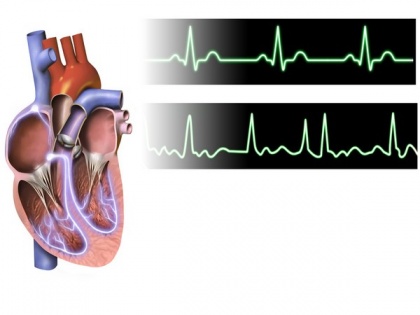Smartphone app detects silent atrial fibrillation in American Indians
By ANI | Published: April 21, 2021 06:31 PM2021-04-21T18:31:22+5:302021-04-21T21:49:44+5:30
A smartphone-based electrocardiogram (ECG) screening accurately detected previously unknown atrial fibrillation in American Indians, and more than half who were diagnosed with the irregular heart rhythm were younger than the recommended screening age of 65, according to new research.

Smartphone app detects silent atrial fibrillation in American Indians
A smartphone-based electrocardiogram (ECG) screening accurately detected previously unknown atrial fibrillation in American Indians, and more than half who were diagnosed with the irregular heart rhythm were younger than the recommended screening age of 65, according to new research.
The results of the research were published today in the Journal of the American Heart Association, an open access journal of the American Heart Association.
About one-third of ischemic strokes, those triggered by blood clots, are caused by atrial fibrillation, the most common heart rhythm disorder. Since many people don't have symptoms and are unaware of its presence, atrial fibrillation often goes undiagnosed.
In some cases, a stroke is the first sign that a person has the disorder. American Indians are more at risk for atrial fibrillation than people in other racial and ethnic groups. As a population, American Indians also have substantially higher rates of obesity, diabetes and high blood pressure - all risk factors for atrial fibrillation.
"We know the risk of atrial fibrillation is high in people who are from racial and ethnic groups, especially among American Indians, so we wanted to see if we could identify silent atrial fibrillation," said lead study author Stavros Stavrakis, M.D., Ph.D., a cardiologist at the Heart Rhythm Institute of the University of Oklahoma Health Sciences Center and associate professor of medicine at the University of Oklahoma College of Medicine in Oklahoma City.
"Systemic screening among American Indians has never been done before, and the true rate of atrial fibrillation in this population is unknown," added Stavrakis.
Researchers enrolled 1,019 American Indians, ages 50 and older, 63% female, who received care at one of four tribal primary care clinics in the Absentee Shawnee Tribal Health System in Oklahoma between January 2019 to June 2020, to examine the feasibility and effectiveness of atrial fibrillation screening using a mobile, smart device.
Participants underwent a 30-second, single-lead ECG using the mobile device paired with a tablet or smartphone at the clinic. An ECG measures the electrical activity of the heart, which can identify abnormal heart rate and rhythm including atrial fibrillation. Researchers compared the ECG results of the screened participants to the results of a control group: 1,267 American Indian adults, ages 50 and older, who received care at the Absentee Shawnee Tribal System clinics during the same time period but did not receive the mobile-based ECG screening.
Their analysis comparing the two patient groups found:
-Of the 1,019 participants who received the mobile-based ECG screening, atrial fibrillation was found in 15 patients (1.5 per cent). In contrast, only four of the 1,267 (0.3 per cent) patients in the control group (standard care, based on clinical symptoms alone) were diagnosed with atrial fibrillation.
-About half of those diagnosed with atrial fibrillation by mobile-based ECG (eight of 15 patients) were younger than 65.
-Patients diagnosed with atrial fibrillation by mobile device were slightly older than those who were not screened with a smart device and did not have the condition.
-Of the 15 patients diagnosed with atrial fibrillation, 14 had a high risk of stroke, as measured by the CHADS2-VASc score (the standard measure to calculate stroke risk) and met the criteria for initiation of blood thinning medication according to current guidelines.
"Our study shows that we have a very simple and accurate method to screen and diagnose atrial fibrillation that is easy to implement at tribal clinics," Stavrakis said. "This widely-available, low-cost approach has real potential to improve health outcomes among American Indians."
American Indians develop cardiovascular diseases at earlier ages than the national average. More than one-third of deaths attributed to cardiovascular disease in American Indians occur before the age of 65, which is the recommended age to begin atrial fibrillation screening according to guidelines from the U.S. Preventive Services Task Force.
People with atrial fibrillation are five times more likely to suffer a stroke than those without atrial fibrillation. So it's vital to be familiar with stroke symptoms.
( With inputs from ANI )
Disclaimer: This post has been auto-published from an agency feed without any modifications to the text and has not been reviewed by an editor
Open in app